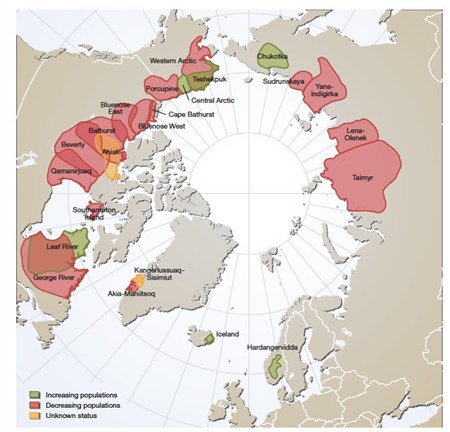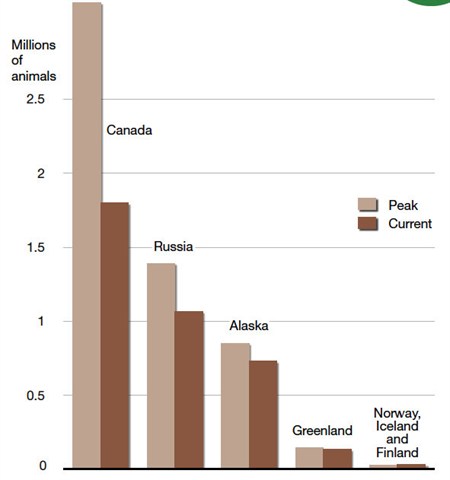If you look at one corner of the Arctic, you might conclude climate change means reindeer are better off. But those that benefit are likely to be the exception rather than the rule, say scientists.
Overall, warming is leading to loss of habitat, food and declining reindeer populations.
Svalbard reindeer
According to an article in yesterday’s Times, reindeer numbers are growing on the Norwegian islands of Svalbard.
The piece is based on data from scientists at the Arctic University of Norway, who have monitored reindeer populations in Adventdalen Valley on Spitsbergen, Svalbard’s main island, since 1979.
The new research suggests the reindeer of Svalbard may be doing OK out of climate change, as melting ice reveals new grazing territory. But this is the latest estimate from one group of researchers, and not all scientists are as confident of such a rosy picture.
Getting a handle on reindeer numbers in these vast and remote landscapes is difficult. This Smithsonian feature from March explores researcher Steve Albon’s efforts to monitor reindeers in Svalbard, where he says the impact of climate change is not yet well understood.
Reindeer in decline
Svalbard is just one part of the Arctic where reindeer live. And the picture looks very different in some other parts.
Across the Arctic as a whole, reindeer are in decline. Populations peaked in the 1990s and 2000s. Since then, studies show wild reindeer and caribou populations have fallen globally by about a third, from 5.6 to 3.8 million. In parts of North America, wild reindeer populations have dropped by more than 75 percent.
How reindeer populations are faring across the Arctic. Green is increasing, red is decreasing and orange is unknown. Source: Arctic Biodiversity Trends 2010
One of the two big reindeer populations in west Greenland declined from about 45,000 to 35,000 between 2001 and 2005. Scientists don’t have enough data on the second one to know for sure how numbers have changed.
Though most of the larger Arctic herds are declining, studies show some smaller populations in Fennoscandia, Russia and Alaska have remained stable or increased in the last few decades.
So what makes some reindeer populations winners and others losers?
Winners and losers
Part of the reason for declining reindeer numbers is likely to be natural factors, driven by continental and atmospheric changes, scientists say. But greenhouse gas warming makes for a far more complicated picture, and is preventing reindeer populations from recovering.
Reindeer experts Liv Solveig Vors and Mark Stephen Voyce from the University of Alberta looked at the role of climate warming and landscape change in the global decline of reindeer in a 2009 paper, concluding:
“While caribou and reindeer populations historically fluctuated, the current synchronous population declines emphasize the species’ vulnerability to global change.”
Since reindeer and caribou populations peaked in the 1990s and 2000s, numbers have fallen globally by about a third. Source: Arctic Biodiversity Trends 2010
The impact of climate change on food availability is an important reason for changing populations. As warming melts ice and extends growing seasons, there’s more opportunity for the plants and shrubs reindeer feed on to grow. But in other places lichen, one of reindeer’s most important winter foods, is decreasing and putting populations under pressure.
Research suggests warmer winters mean more precipitation falls as rain rather than snow, which refreezes and blocks reindeer’s access to vegetation. Albon’s team reported the average weight of adult females was about nine kilograms lower after a wet winter than one with average rainfall. More frequent wet winters could damage the health of the population, the scientists warn.
However, hard evidence about the impact of warm winters on feeding habits is still fairly thin on the ground, and not all scientists agree it’s a problem.
Other studies suggest plant growth could become out of sync with when reindeer calves are born, meaning fewer survive. And where reindeer do have access to food, its nutritional quality may be declining. The latest report from the Intergovernmental Panel on Climate Change (IPCC) report says:
“[T]he overall quality of forage may decline during warming, for example if the nitrogen content of key fodder species for ungulates were to drop during warming”
Under pressure
There aren’t any simple answers for how climate change is affecting reindeer. It varies depending on where in the Arctic you look, which is why it’s important to take a broad view.
Human activity also affects reindeer numbers beyond just changing the climate. Scientists say in Russia, hydrocarbon extraction is a bigger threat than climate change to reindeer numbers.
But the bottom line from scientists is that while some small populations may be bucking the trend, further warming spell bad news for reindeer right across the icy expanses of the Arctic.



